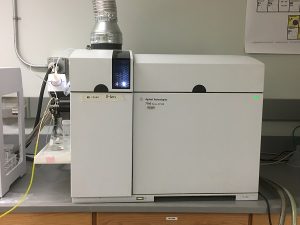Instruments
All instruments are overseen or managed by Dr. Justin B. Richardson
Depending on the samples, elements of interest or instrument, samples can be analyzed with no preparation, minimal processing (drying and sieving), or full processing for extractions, strong acid digestions.

Inductively Coupled Plasma – Mass Spectrometer
– Agilent 7900x
Inductively Coupled Plasma – Optical Emission Spectrometer
– Agilent 5800
Solid phase samples (soils, rocks, minerals), plants (wood, leaves, roots), organismal samples (muscle tissues, shells, exoskeletons), and water samples.
Solid samples must be prepared by drying, sieving, homogenization, and extracted or digested.
Plant available, organic-bound, and oxyhydroxide phases can be extracted from samples using selective dissolution/operationally-defined extractions. Soils, rocks, and minerals can be digested with aqua regia (HCl or HNO3) or totally dissolved w(HF and HNO3).
Water samples must be filtered < 0.45 μm and acidified.
Raw data are compared with USGS and NIST standard reference materials as well as blanks, duplicates, and spiked samples for QA/QC.
Elements that can be measured:
Macronutrients (Ca, K, Mg, P, S) and micronutrients (Na, Mo, Cr, Mn, Fe, Co, Ni, Cu, Zn)
Geologic and rare earth elements (Al, Si, Fe, Mn, Sr, Rb, Bi, Ti, Zr, Nb, Ce, Pr, Nd, Sm, Eu, Gd, Tb, Dy, Ho, Er, Tm, Yb)
Toxic elements (Sn, Sb, Pb, Cd, As, Th, U)
Bruker Puma S2 – Energy Dispersive X-Ray Fluorescence
Solid phase samples (soils, rocks, minerals) are powdered and analyzed for total elemental concentrations using X-Rays and compared with USGS and NIST standard reference materials.
Sample preparation may include crushing and homogenizing to < 1 μm powder.
Elements that can be measured from the % to 100 ppb range:
Macronutrients (Ca, K, P) and micronutrients (Cr, Mn, Fe, Co, Ni, Cu, Zn)
Geologic elements (Al, Si, Fe, Mn, Sr, Rb, Ba, Bi, Ti, Zr)
Toxic elements (Sn, Sb, Pb, Cd, As)
Bruker D6 Phaser – X-Ray Diffractometer
Solid phase samples (soils, rocks, minerals) are analyzed mineral composition (based upon diffractogram peaks and subsequent d-spacing) and approximate mass fraction (LOD 3% by mass).
Sample preparation may include crushing and homogenizing to < 1 μm powder.
Clay sized fraction mineralogy can be determined with size and expanding/drying treatments.
Raw data are compared with diffractogram library and internal spikes and duplicates.
Portable X-Ray Fluorescence
Solid phase samples (soils, rocks, minerals) are analyzed using X-Rays and compared with USGS and NIST standard reference materials.
Elements that can be measured:
Macronutrients (Ca, K, P) and micronutrients (Cr, Mn, Fe, Co, Ni, Cu, Zn)
Geologic elements (Al, Si, Fe, Mn, Sr, Rb, Ba, Bi, Ti, Zr)
Toxic elements (Sn, Sb, Pb, Cd, As)

Soil processing, preparation, and basic physicochemical measurements are conducted within the Clark Hall, wet-dry trace metal biogeochemistry laboratory. Equipment includes drying ovens, centrifuges, digital scales and digital microbalance, glassware, pH probes, Eh probe, salinity probe, plastic ware, solvents, solutions, standards and other tools, materials, and equipment for soils, rocks, minerals, plants, and invertebrate sample processing. Animal samples and sensitive samples for isotopic analyses are processed and digested in other laboratory spaces in Clark Hall.
